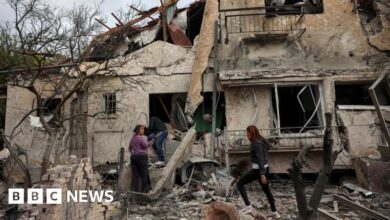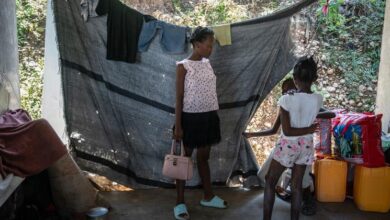Gaza: WHO chief highlights health risks of latest evacuation order

WHO Director-General Tedros Adhanom Ghebreyesus told journalists that Al-Ahli Hospital and the Patient Friendly Hospital in northern Gaza were the latest facilities to be rendered inoperable due to nearby fighting.
Patients from Al-Ahli were evacuated to Hospital Indonesia, which is currently operating at three times capacity, he said.
Thousands of people are waiting to be evacuated.
“More than 10,000 patients still need medical evacuation to treat what cannot be provided in Gaza,” he said, stressing that “there is a need for more emergency evacuation corridors to the West Bank, Egypt and Jordan.”
Tedros noted that virtually the entire population of Gaza is facing severe food insecurity, with nearly a quarter of the population at risk of starvation.
Meanwhile, very little aid has been brought into the area, with only five WHO trucks allowed in last week.
Aid stuck at the border
Tedros said more than 34 trucks were waiting at the El Arish border crossing with Egypt, with 850 pallets of supplies waiting to be picked up and another 40 trucks stopped at Ismailiya, also in Egypt.
He called for the immediate lifting of restrictions on supplies into Gaza, saying “the people of Gaza who have nothing to do with this conflict are not the ones paying the price for it”.

People inspect damage after a school was bombed in central Gaza.
‘Ideal place for disease to thrive’
WHO Regional Director for the Eastern Mediterranean, Dr Hanan Balkhy, also briefed reporters on her 11-day visit to the occupied Palestinian territories, describing the situation in Gaza as “very worrying from both a human and humanitarian perspective”.
She said fuel shortages were affecting all medical and humanitarian operations there, as sewage and garbage flowed down destroyed streets and the smell of rotting waste filled the air.
“This situation is creating an ideal environment for diseases to spread, leading to increased cases of acute diarrhoea and acute respiratory infections among others,” she said.
Breakdown in law and order
“Ongoing violence and breakdown of law and order are devastating an already devastated city. and create an extremely high-risk environment – not just for aid workers, but for everyone in Gaza,” she added.
The breakdown of law and order also makes managing gender-based violence nearly impossible, exposing displaced Palestinians to life-threatening risks.
Although WHO has expanded medical supply chains to Gaza in response to the growing hostilities and rising needs, much of this aid remains “stuck on the other side of the border,” she said, echoing Tedros.
“And even when supplies are disrupted – I repeat – law and order makes it difficult for our teams to get them to the hospitals in urgent need,” she added.
Open borders
Dr. Balkhy also shared about her visit to the IMC Field Hospital in Deir Al-Balah in central Gaza, which has been relocated twice and tripled in capacity over the past few months.
She met a severely malnourished seven-year-old girl who had been evacuated from the north three months ago and was one of 10,000 patients waiting to be evacuated outside Gaza so they could receive specialist care for conditions such as trauma and chronic illnesses.
While in the region, the senior WHO official also held meetings with the UN Humanitarian Coordinator for the Occupied Palestinian Territories, Muhannad Hadi, and the UN Special Envoy for the Middle East, Tor Wennesland, and they all agreed on the need to address the suffering in Gaza.
“We need member states to quickly do their global diplomatic duty and push for an immediate ceasefire.“, she shared from Cairo, Egypt.
“We need all borders, including the Rafah border, to be open and allow fuel, medical supplies and other essential humanitarian aid to flow in, and we need people who need medical care to be able to get out.”
Attacks in the West Bank continue
Dr. Balkhy also traveled to the West Bank and witnessed the rapidly deteriorating health situation there.
She visited Jenin General Hospital and a clinic run by the UN Palestinian refugee agency. UNRWAand learned about the health workers who were killed or injured in the repeated attacks. She also witnessed extensive damage to infrastructure and medical equipment.
Given the damage to roads and limited access, WHO and partners, including the Palestinian Red Crescent Society, have set up mobile health services to reach people at the scene of the injuries, she said.
The UN agency also supported training in mass casualty management and response planning at Jenin General Hospital and six other hospitals in the West Bank.
“Our goal is efficient and seamless trauma care. at all levels, building on the lessons from Gaza,” she said.
Support regional health systems
Dr Balkhy also stressed the need to strengthen the already fragile health systems in neighboring Jordan, Lebanon and Syria.
She voiced deep concern about the escalating violence along the border between Lebanon and Israel, which has resulted in increased civilian and health worker deaths and injuries, as well as displacement and damage to health infrastructure.
“In our region, generations have grown up knowing nothing but conflict and deprivation.“Addressing the root political causes of these emergencies is not only a humanitarian imperative but also a strategic investment in regional stability and security,” she said.
Reduced food intake
The United Nations and aid partners continue response efforts as the humanitarian crisis in Gaza continues.
World food program (World food program) assisted about a quarter of a million people this month and provided rations to more than a million people in June, speak United Nations spokesman Stéphane Dujarric speaks in New York.
“However, limited food stocks in central and southern Gaza forced WFP to cut rations last month, with some areas receiving only flour,” he said.
Supplies are running low.
WFP has also worked with dozens of community kitchens to provide some 1.8 million hot meals to people in central and southern Gaza, as well as Gaza City, since early July.
“But the agency warned that the supplies needed for this support would be exhausted within days if no additional supplies were received,” Mr. Dujarric said.
Meanwhile, humanitarian organizations are providing vital assistance to people displaced from northern to southern Gaza following Israel’s latest order to leave Gaza City.
Includes water, hot meals, food packs and health and nutrition support.




